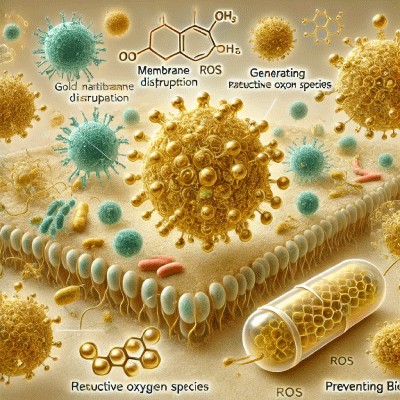Antibacterial Use and Applications of Gold Nanoparticles: Revolutionizing Healthcare
Gold nanoparticles (AuNPs) have garnered significant attention in the biomedical field due to their unique properties, including their remarkable antibacterial capabilities. This page delves into the antibacterial use and applications of gold nanoparticles, exploring how they are transforming healthcare and offering new solutions for combating bacterial infections.
Understanding the Antibacterial Properties of Gold Nanoparticles
Gold nanoparticles exhibit potent antibacterial activity, which is influenced by their size, shape, surface charge, and functionalization. These nanoparticles can effectively disrupt bacterial cell membranes, generate reactive oxygen species (ROS), and interfere with essential cellular processes, leading to bacterial death. The antibacterial efficacy of AuNPs can be tailored by modifying their surface with specific ligands, making them highly versatile for targeted applications.
- Mechanisms of Action: Gold nanoparticles can kill bacteria through multiple pathways:
- Membrane Disruption: AuNPs can attach to bacterial cell membranes, causing structural damage and leakage of cellular contents.
- Reactive Oxygen Species (ROS) Generation: AuNPs can induce the production of ROS, which cause oxidative stress and damage to bacterial DNA, proteins, and lipids.
- Inhibition of Enzyme Activity: By binding to bacterial enzymes, AuNPs can inhibit essential biochemical processes, leading to cell death.

An illustration showing gold nanoparticles acting as an antibiotic. The image visually represents gold nanoparticles interacting with bacterial cells, causing membrane disruption, generating reactive oxygen species (ROS), and preventing biofilm formation. The image focuses on the interactions between the gold nanoparticles and bacteria, highlighting their potential as an antibacterial agent. This visual could be useful for educational and research purposes to demonstrate how gold nanoparticles work as an antibiotic.
Applications of Gold Nanoparticles in Antibacterial Therapies
The versatility and effectiveness of gold nanoparticles make them ideal candidates for various antibacterial applications. Below are some of the most promising uses of AuNPs in combating bacterial infections:
-
Wound Dressings and Coatings: Gold nanoparticles are increasingly used in wound dressings and coatings to prevent bacterial infections. Their ability to inhibit bacterial growth on wounds can significantly reduce the risk of infections in burn victims and surgical patients. For example, AuNP-coated bandages can provide continuous antibacterial action, promoting faster wound healing and reducing the need for frequent dressing changes.
-
Drug Delivery Systems: AuNPs can be functionalized to carry antibiotics directly to infection sites, enhancing the efficacy of the treatment while minimizing side effects. This targeted approach helps in overcoming bacterial resistance by ensuring higher concentrations of the antibiotic at the site of infection, reducing the likelihood of resistance development.
-
Medical Device Coatings: Bacterial infections associated with medical devices, such as catheters and implants, are a significant concern. Gold nanoparticles can be used to coat these devices, providing a protective antibacterial layer that reduces the risk of infection. The non-toxic nature of AuNPs makes them suitable for long-term applications in the body.
-
Antibacterial Paints and Surfaces: Beyond healthcare, gold nanoparticles are being explored in the development of antibacterial paints and coatings for use in hospitals, food processing plants, and public spaces. These surfaces can actively kill bacteria upon contact, reducing the spread of infections and contributing to a cleaner environment.
Advantages of Gold Nanoparticles in Antibacterial Applications
Gold nanoparticles offer several advantages over traditional antibacterial agents, making them a preferred choice in various applications:
- Broad-Spectrum Activity: AuNPs are effective against a wide range of bacterial strains, including antibiotic-resistant species such as MRSA (Methicillin-resistant Staphylococcus aureus).
- Reduced Resistance: The multifaceted mechanism of action of AuNPs makes it difficult for bacteria to develop resistance, unlike conventional antibiotics.
- Biocompatibility: Gold is inherently biocompatible, reducing the risk of adverse reactions when used in medical applications.
- Customization: The surface of gold nanoparticles can be easily modified with different functional groups, enabling the development of tailored antibacterial solutions for specific applications.
Future Prospects and Research Directions
The antibacterial applications of gold nanoparticles are a rapidly growing field, with ongoing research focused on enhancing their efficacy and exploring new uses. Future developments may include the combination of AuNPs with other antimicrobial agents to create synergistic effects, as well as the integration of gold nanoparticles into smart materials that can respond to environmental triggers.
As the threat of antibiotic resistance continues to rise, gold nanoparticles offer a promising solution for the development of new antibacterial therapies and preventive measures. Their unique properties and versatility position them at the forefront of innovation in the fight against bacterial infections.
For more information and to explore their products, visit the Nanopartz™ website. Happy researching!
Go here for Nanopartz Gold Nanoparticles

